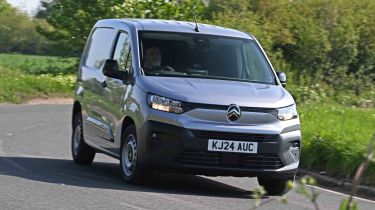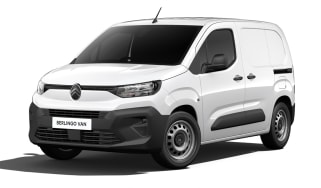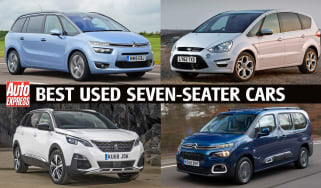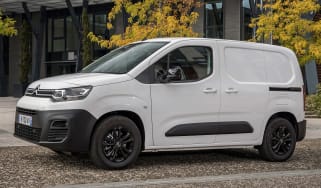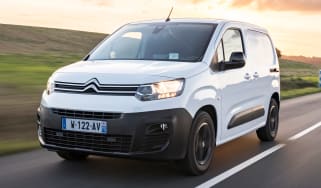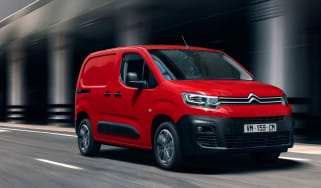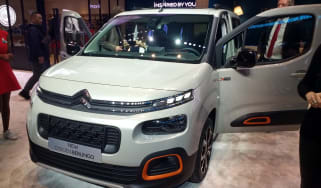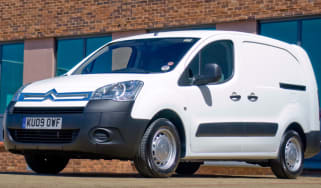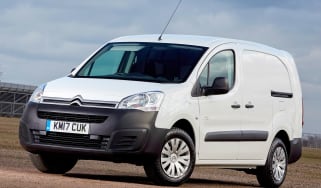Citroen Berlingo Van review
The French brand’s Citroen Berlingo small van is a strong contender in a competitive class
Our opinion on the Citroen Berlingo Van
The Citroen Berlingo is a fairly ubiquitous contender in the small van category. The name has been in use since 1996, while the current model has been around since 2018. It set a new benchmark for the small van sector when it was launched, and it’s still a competitive proposition today, with decent payload weights, reasonable space for a small van and low running costs, whether you choose a diesel model or an all-electric option. A facelift at the end of 2024 introduced more tech, but it didn’t come at the expense of the Berlingo’s all-round ability.
About the Citroen Berlingo Van
Ever since the 2CV, Citroen has built versatile small commercial vehicles that have been popular with the masses. While the Ami Cargo is technically the smallest working model that Citroen sells, it’s the Berlingo that is the company’s challenger in the small van sector. This third generation was introduced in 2018, while an update at the end of 2024 introduced a new look and updates for the cockpit and running gear.
The Citroen Berlingo has become a staple of the small van class, almost becoming shorthand for the category, but the Mk3 set a new benchmark for practicality and car-like features. That’s because it uses a platform that shares parts with cars such as the Peugeot 308, so Citroen was able to add some new safety tech. Further updates in 2024 added improved connectivity and a narrower price gap between the diesel and electric variants.
Used - available now

2022 BMW
3 Series
37,155 milesAutomaticPetrol2.0L
Cash £18,897
2023 Mercedes
A-Class Saloon
9,433 milesAutomaticPetrol1.3L
Cash £18,697
2023 Hyundai
Bayon
23,186 milesManualPetrol1.0L
Cash £12,197
2020 Volkswagen
Polo
65,623 milesManualPetrol1.0L
Cash £10,397Prices start from around £21,500 for the diesel version of the Berlingo, while the electric version kicks off at £25,500, although if you want a diesel Berlingo with a similar power output to the electric version then that’s around £24,000. There are two bodystyles called M and XL with a single roof height offered; the former features a single sliding side door, the latter has a sliding door on either side. A five-seat Berlingo Crew Van is also available.
Diesel power comes from Stellantis’ Euro 6-compliant 1.5 BlueHDi unit. There are two variants offered, a 101bhp unit connected to a six-speed manual gearbox, and a 129bhp version that comes with an eight-speed automatic. Both are front-wheel drive, while the optional Worksite Pack raises the ride height by 15mm, adds mud and snow tyres and a more advanced traction control system in lieu of four-wheel drive.
The electric e-Berlingo features a 52kWh battery (up from 50kWh pre-facelift) and a 134bhp electric motor driving the front wheels.
Trim variants comprise Enterprise and Driver, while Citroen has added an Enterprise Plus version that is designed to offer a bit more value for money. All trims and engines are available in both M and XL body styles, while the Crew Van is XL only because it needs the extra length for rear legroom, and is also only offered in more basic Enterprise spec.
Standard kit is fair, with all models featuring air conditioning, electric windows, Bluetooth, rear parking sensors, cruise control, lane-keep assist, auto lights, remote central locking and a multifunction steering wheel. On top of this, Enterprise Plus adds a through-loading bulkhead and twin front passenger seats, while a 10-inch touchscreen infotainment system with smartphone mirroring is added, as is a 10-inch driver’s display.
The Driver variant adds wheel trims and a digital rear-view mirror with side view, rear camera with 180-degree view, rain-sensing wipers, and the touchscreen is upgraded with navigation and voice control.
MPG and running costs
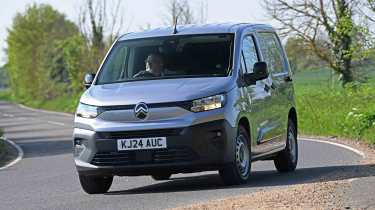
| Pros |
|
| Cons |
|
Prices for the Citroen Berlingo have risen with the introduction of more safety kit, and the line-up starts at around £21,500 for the diesel models, while the electric versions now start at £28,000 or so. Upgrading to the longer XL model costs around £1,000 extra, while moving from the 100 BlueHDi to the 130 BlueHDi auto costs around £2,500. The Crew Van starts at £24,000, with the electric version costing around £5,500 more.
Citroen offers option packs to upgrade the Berlingo experience. The Drive Assist pack is around £1,250 and adds adaptive cruise control, traffic sign recognition and extra safety kit, while the Worksite Kit (£500) adds Grip Control electronics, a 15mm-taller ride height, a front skid plate and Mud & Snow tyres for some limited off-road ability. This is only available in Enterprise trim, but can be added to the Crew Van as well as the standard panel versions.
The Enterprise pack is a £1,000 add-on for the entry trim that adds the 10-inch touchscreen infotainment and 10-inch driver’s display, plus the rear 180-degree camera system and a Thatcham-approved alarm.
The e-Berlingo has an optional Winter Pack (£750), with a heat pump, heated steering wheel and automatic air-conditioning that helps boost overall driving efficiency in colder months.
Fuel economy for the diesels is good, with the best figures for the BlueHDi 100 manual at 54.4mpg. The best figure for the BlueHDi 130 auto is 51.9mpg. Interestingly, the quoted figures for the M and XL bodies are the same, and that’s also the case with the Crew Van.
The diesel models feature engine stop-start, although our experience with the system hasn’t been too favourable, with the system hardly ever cutting in during stop-start traffic. Turning the air-con on and off and deselecting the windscreen demister didn’t seem to make a difference, either.
To help combat emissions, the Berlingo diesel has an AdBlue system, with a 17-litre tank on board that requires filling every few thousand miles – the van’s trip computer will let you know when. The filler is located next to the diesel neck for convenience.
Electric range, battery life and charge time
The 2024 facelift saw a new 52kWh battery added to the Berlingo, up slightly over the old model’s 50kWh pack. As with the diesels, the official range of 220 miles is quoted for every variant of the electric, whether it’s M, XL or Crew Van. The City range is quoted at up to 304 miles, which shows how the e-Berlingo’s powertrain is geared towards urban use.
That’s where the electric model will do its best work, and when we’ve tested this powertrain, it’s clear that faster driving really blunts the van’s range. Keep to lower speeds, and you should be able to easily cover 200 miles between charges.
There’s a CCS charging socket located on the rear quarter panel in the same position as the fuel filler on the diesel van, but the maximum DC rate the e-Berlingo can accept is 100kW. This will take the battery from zero to 80 per cent capacity in half an hour, but charging slows significantly once past this mark.
If you’re charging via AC, then a domestic supply will fully charge the battery from flat in a massive 31 hours (and 10 minutes), a 7.4kW home wallbox can do the same job overnight (seven hours 30 minutes) while three-phase 11kW charging takes just over five hours. The latter is only available as an option (£350), though.
Load space and practicality
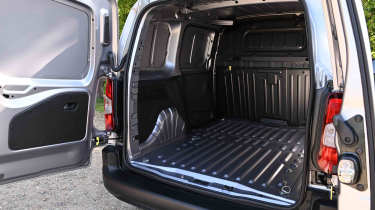
| Pros |
|
| Cons |
|
The Berlingo van uses the front section of the PSA Group's EMP2 chassis combined with a revised rear end sourced from the previous-generation Berlingo. Changes to the suspension and load floor, as well as the introduction of a more upright body, mean the Berlingo M has a load volume of 3.3 cubic metres, while the XL has an extended wheelbase (up from 2,785mm to 2,975mm) and a longer rear (it’s 4,753mm long, compared with 4,403mm for the M) to create 3.9 cubic metres of space.
Vans fitted with the Extenso pack have additional loading capacity, courtesy of a removable panel in the steel bulkhead that detaches to reveal a 612x298mm access hatch. This allows lengthy items up to 3.1 metres long (or 3.4m in the XL) to be loaded – the load length without the Extenso system in use is 1.82 metres, or 2.17 metres in the XL. The pack also includes a vinyl cargo bag that hooks around the opening to help protect the cab from damage by longer objects.
The Extenso pack features a twin passenger seat in the cab, and the outer chair folds down in one motion to allow longer items to be carried. The outer seat base can also flip up to add a 500-litre storage area in the front of the van, while the middle seat also flips up to reveal extra storage, or the backrest cushion folds down for a tray table.
A rear sill height of 547mm for M models and 571mm for the XL boosts access. The width between the wheelarches is 1,229mm, so there's enough room for two Europallets in the back of the Berlingo. The rear door opening measures 1,241mm wide by 1,196mm high, while the side access measures a minimum of 641mm wide by 1,072mm high.
The Crew Van features a clever moving bulkhead, so you can choose between passenger and cargo carrying. The back seats fold flat into the floor in one motion, and then the steel mesh bulkhead behind can be slid forward to just behind the front seats. This creates 3.5 cubic metres of space, so only 0.4 cubic metres down on the XL panel van, while there’s 1.8 cubic metres on offer in the five-seat setting.
Reliability, safety and security

| Pros |
|
| Cons |
|
Because the Berlingo uses a car-derived platform, it features a lot of driving and safety-assist systems. For the 2024 update, the once-optional passenger, side and curtain airbags were made standard to improve safety, while the full-height steel bulkhead between the cargo and passenger areas helps to keep heavy cargo from joining you up front in a forward collision – for comparison, some rivals offer only a reinforced plastic bulkhead instead of a proper steel plate.
The old van’s Safety Pack is now fitted as standard, so all models come with lane-departure warning and assistance, driver-attention alert and speed-limit recognition (which should be helpful on unfamiliar roads where you don’t know what the speed limit is). Including this tech and autonomous emergency braking has helped the Berlingo achieve a Gold rating in the Euro NCAP commercial vehicle tests. However, the automatic emergency braking system wasn’t very good at recognising cyclists, and didn’t work so well at avoiding collisions at higher speeds. Its rival, the Mercedes Citan, performed much better, gaining a higher Platinum rating due to its superior assistance systems.
Tyre-pressure monitors are standard on all models, while a spare wheel is a £140 stand-alone option, or comes as part of the off-road-minded Worksite Pack.
Citroen’s Surround Rear Vision set-up is standard on Driver trim, but optional as part of the Enterprise Pack on entry-level models, and includes front and rear parking sensors, plus side and rear cameras; you can view the feed from these on a five-inch display that’s fitted where the rear-view mirror would normally be mounted. The side-view camera, which is activated with a press of the button on the end of the left-hand column stalk, boosts vision in the nearside blind spot, but has a rather wide angle, making it a bit tricky to see traffic until it's nearly upon you. Still, it's a handy extra to help with positioning on the road.
Considering the Berlingo shares parts, engines and EV running gear with numerous other models within the Stellantis empire, we have no doubt it will be a reliable van for business users. And as EVs are generally cheaper to service than petrol or diesel alternatives, you should save some money on maintenance.
Security features include remote central locking with separate locking for the cab and load area, an engine immobiliser, a visible VIN plate and hidden rear door hinges – a first for the Berlingo. All Berlingos are fitted with an immobiliser, but you’ll need to specify an alarm as a £250 option on the entry-level Enterprise trim. The Driver model comes with a Thatcham category 1 approved alarm.
Driving and performance
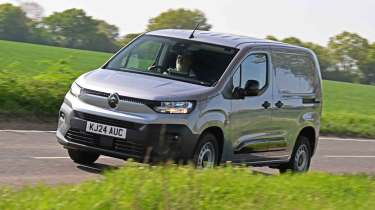
| Pros |
|
| Cons |
|
The Berlingo is reasonably comfortable on the move, while supportive seats and a natural driving position boost comfort. This is helped by the reach and rake-adjustable steering wheel and standard lumbar adjustment. The Berlingo features a slightly different seat design when compared with its Fiat Doblo, Peugeot Partner, and Vauxhall Combo siblings, with denser foam and thicker side bolsters for greater comfort. That might be a reason to choose the Berlingo over its rivals if you spend most of your day in the driving seat.
Big windows give a good view out, but the mirrors have a fairly narrow viewing angle, so this creates blind spots down either side of the van – you can angle them to see what’s behind you or further out to either side, but it would be nice if there was a wider field of view. The nearside camera does help with the blind spot on that side of the van, but it’s always best to check over your right shoulder when joining motorways, for example.
Decent sound deadening helps to make the Berlingo’s cabin more refined than its predecessor’s. The 1.5 BlueHDi’s six-speed manual gearbox makes the most of the power on offer, and there's no lack of urge to help haul heavy payloads.
The E-Berlingo’s electric motor is quieter still, and actually delivers around 30Nm less torque than the most powerful diesel model, but because all of it is available from zero rpm, it doesn’t really feel any slower or leave you wanting a stronger pull. Switching between the Eco, Normal and Power drive modes does affect how much power is on tap, with the latter only really required if you’re carrying a heavy payload. But unless you prefer the snappier accelerator response of Power mode all the time, you won’t have to worry about having to switch modes in everyday driving, because you’ll get full power when you floor the throttle.
Town driving, visibility and parking
Light steering helps with low-speed driving and parking, while standard rear parking sensors take some strain out of everyday driving. The rear camera is useful when reversing, too. One area for criticism is the manual model’s gearbox, which is a little vague in its action, but you can tune into the slackness and work around it.
The automatic model is fine, it’s a lot better than past autos, with less hesitancy to find the right gear at roundabouts, for example.
The e-Berlingo features variable regenerative braking for the first time. It’s a welcome improvement because you use paddles behind the steering wheel, rather than having to select 'B' mode with the drive selector as before. Using the regenerative-braking system recovers energy for the battery when you slow down for roundabouts or traffic, improving your efficiency when driving around town. But it isn’t as strong as the system used on the bigger e-Relay, and can’t bring you to a full stop. It doesn’t provide a one-pedal driving experience.
Motorway driving and long-distance comfort
On faster roads, the e-Berlingo is considerably more relaxing than the diesel model. As with most electric vans, there’s far less vibration and a lot less noise entering the cabin. The electric model even rides well with no cargo on board, because the battery is located under the floor between the axles, meaning the van’s mass is concentrated low down, which helps keep the chassis settled over rough tarmac. We’d deactivate the regenerative braking at higher speeds, though, just to give a smoother response when lifting off the accelerator.
Cab interior and technology
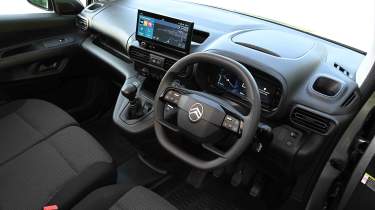
| Pros |
|
| Cons |
|
The Berlingo is a workhorse, so the presence of hard scratchy plastics in the cabin shouldn’t come as a surprise. The cabin feels tough enough to soak up the sort of abuse they’re liable to face at work, and generally, the van feels well built.
The dashboard layout is clear and easy to get on with, with the climate controls separate from the touchscreen. The temperature is adjusted via a rotary control, as is the fan speed, while big square buttons control the rest of it, so you can operate them while wearing gloves.
Space is good on board, with plenty of headroom and enough space for an overhead storage shelf. Two-seat models have plenty of room, and feature a flip-up armrest for the driver, but there's no additional storage between the seats. The two-seaters also have a manual handbrake, but those with the Extenso pack and twin passenger seats replace this with an electric handbrake.
These seats are a little narrow compared with the single-seat layout – especially in terms of shoulder space and kneeroom for the middle passenger, because of the shape of the dashboard – but the added flexibility of the seats compensates for this. The outer seat flips up to create additional storage, while the back folds down to allow extra-long items to be loaded through from the cargo area. Even better is the addition of a vinyl bag that helps protect the cabin from damage.
The middle seat is narrow, but the back can be folded down to create a tray table. This is in addition to a tray on top of the middle of the dashboard, while there's a lidded bin above the dials, too, although this isn’t very deep. There are also twin gloveboxes, with a large upper storage area with room for a 15-inch laptop inside. The lower glovebox is slightly compromised by the fuse box taking up space, but it's not as severely impacted as some other models.
Also included are decent door bins, as well as 12-volt sockets and USB charging connections, while extra charging can also be added in the load area.
In the Crew Van, there’s a 2+3 layout, so front space is improved. The back row is fixed in place and a little upright, while the cushions are on the firm side. Intriguingly, glazing for the sliding side doors is only an option, so the standard steel doors make it feel claustrophobic.
Infotainment, sat-nav and stereo
The basic Berlingo comes with a phone cradle to put your smartphone in and use its apps, or there’s a revised 10-inch high-definition touchscreen with standard sat-nav on Enterprise Plus and Driver models (and optional on Enterprise trim, too). It works well and responds swiftly to commands, and it’s pleasing that you get physical home and vehicle settings shortcut buttons next to a volume control dial. The vehicle settings button is the one you need if you want to deactivate any of the safety systems if you get tired of the warning beeps.
The screen comes with both Apple CarPlay and Android Auto smartphone connectivity, should you wish to use your own apps, and we found the system connected easily, both via cable (you’ll need a USB-C lead to do this on the 2024 model) and wirelessly.
There’s also WiFi, because Citroen is pushing its Free2Move data planning service. This allows businesses to send daily delivery schedules to individual drivers, which gives them information such as an address to send to the built-in sat-nav or a contact number should they need to call a customer. It can also give fleet managers reminders for scheduled maintenance of their vans or a warning if a breakdown occurs. This service could be useful if your business doesn’t already have such software.
Citroen Berlingo Van alternatives
The most obvious alternatives to the Citroen Berlingo are the vans that share the same bodyshell and running gear. There are slightly different specifications, depending on which model you choose, but they all offer the same capability, so the deciding factor between them could be as simple as the best finance offer, or even which one has the closest dealership. The Peugeot Partner has a slightly different cabin because it features Peugeot’s iCockpit, with a small steering wheel and high-set dials, but the Vauxhall Combo and Fiat Doblo are all but identical to the Berlingo for powertrains and spec.
Elsewhere, the Toyota Proace City is also part of the same family of vans, although Toyota’s version has the added attraction of a potential 10-year warranty if you keep up regular maintenance at a franchised service centre.
The Renault Kangoo, Mercedes Citan and Nissan Townstar are a similar parts-sharing exercise and come in diesel or electric guises, while the Ford Transit Courier comes with petrol, diesel or electric drive. There’s also the larger Transit Connect, which shares its running gear with the Volkswagen Caddy, but the engine choices here are petrol, diesel or plug-in hybrid, with no electric option offered.
If you want to splash out on an electric van, the Volkswagen ID. Buzz Cargo is a pricey but distinctive option, and new to the market in 2025 is the Kia PV5, which looks larger than the Berlingo, but has competitive cargo capacities and up to 250 miles of electric range, as well as a seven-year warranty.
Van dimensions | |||
| Body style | Height | Width | Length |
| Berlingo M | 1,796mm | 1,848mm | 4,403mm |
| Berlingo XL | 1,812mm | 1,848mm | 4,753mm |
| Berlingo Crew Van | 1,812mm | 1,848mm | 4,753mm |
Load area dimensions | ||||
| Body style | Height | Width | Length | Volume |
| Berlingo M (w/Extenso) | 1,200mm | 1,527mm | 1,817mm (3,090mm) | 3.3m3 (3.8m3) |
| Berlingo XL (w/Extenso) | 1,270mm | 1,527mm | 2,167mm (3,440mm) | 3.9m3 (4.4m3) |
| Berlingo Crew Van | 1,243mm | 1,527mm | 1,450mm | 1.8-4.0m3 |
(Width between wheel arches: 1,229mm)
Frequently Asked Questions
We’d have to say yes, it’s a strong contender in the class. It has good space and is decent to drive, especially as an EV, although the fact that it’s one of five vans that are essentially identical apart from a few minor details means that it will need some strong finance incentives to help with sales.
